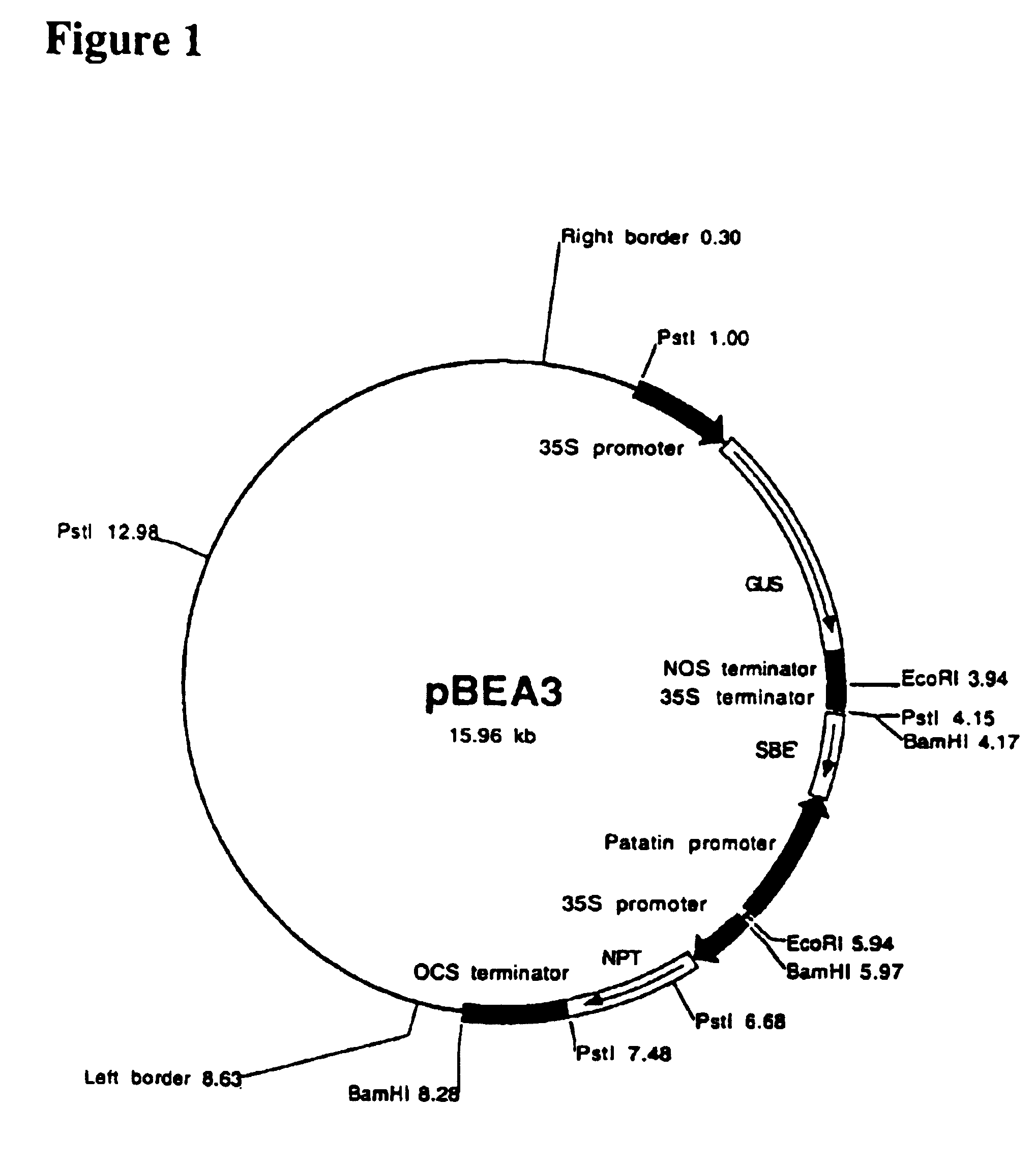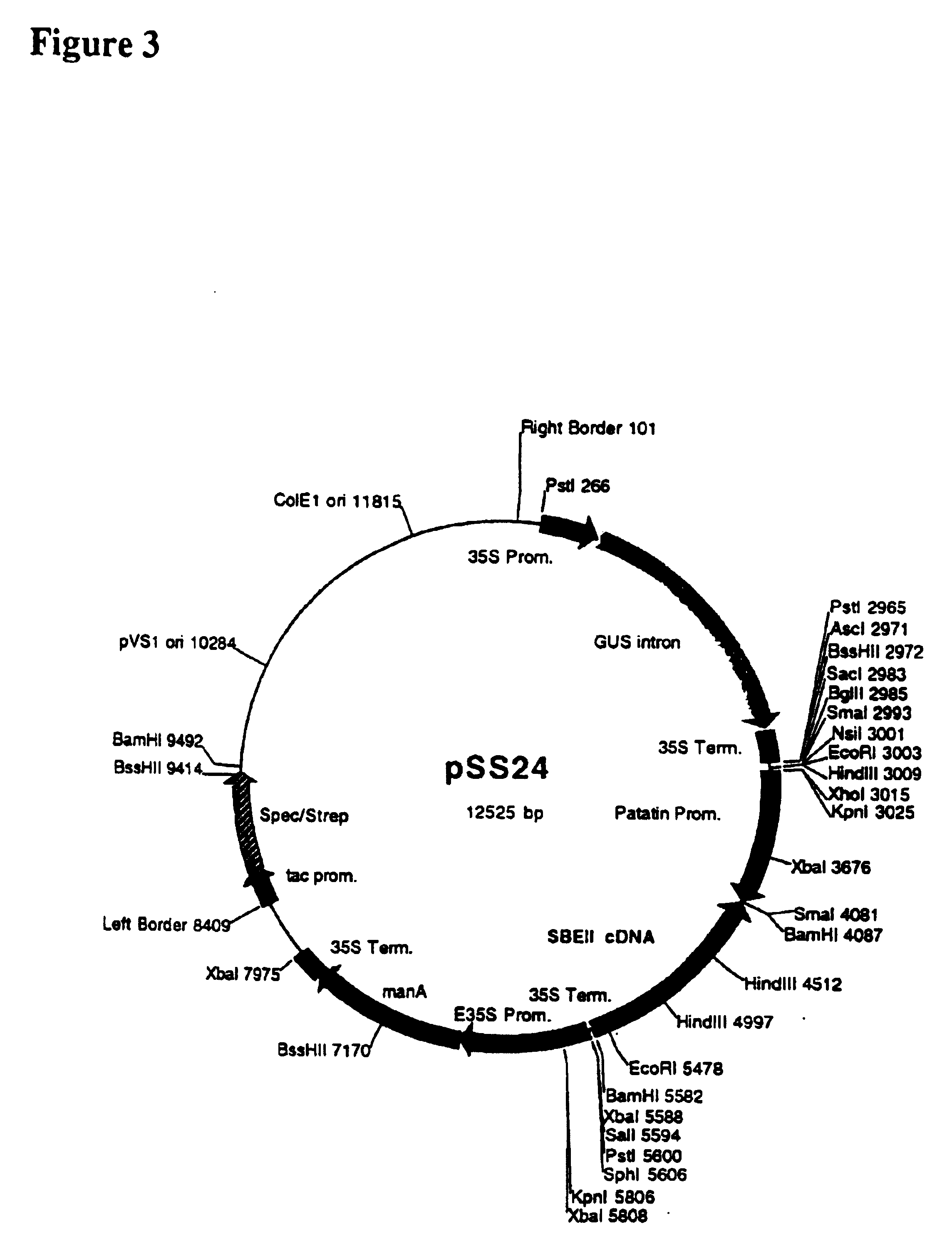Enzyme
a technology of enzymology and enzymes, applied in the field of enzymology, can solve the problems of inability to readily obtain starches with these properties in plants, high cost of treatment, etc., and achieve the effects of less detrimental effect on the environment, more reliably and/or more efficiently, and affecting enzymatic activity
- Summary
- Abstract
- Description
- Claims
- Application Information
AI Technical Summary
Benefits of technology
Problems solved by technology
Method used
Image
Examples
example 1
Reduction of Endogenous Starch Branching Enzyme Activity
[0111] Glucan branching enzyme (GBE) activity is reduced in plants by expressing antisense GBE nucleic acids in said plants. This is accomplished using SBE I antisense expression, or using SBE II antisense expression, or using SBE I and SBE II antisense expression, as discussed herein.
[0112] Reduction of starch branching enzyme activity by antisense SBE I expression.
[0113] Nucleic acid constructs for the expression of antisense SBE are prepared.
[0114] A 692 bp EcoRI fragment from the 5' end of a potato starch branching enzyme I (SBEI) cDNA (Poulsen and Kreiberg (1993) Plant physiol 102:1053-1054) is inserted in antisense orientation after a patatin class I promoter in plasmid pPATA1 (see WO94 / 24292). From the resulting plasmid, pGBE3, the antisense SBEI cassette is isolated as a 1996 bp EcoRI restriction fragment, which is inserted into the plant transformation vector pBKL4 (see WO94 / 24292) yielding plasmid pBEA3 (shown in FIG....
example 2
Cloning of Genes Encoding Glucan Branching Enzymes (GBEs)
[0136] GBE genes are isolated for heterologous expression in organisms according to the present invention, such as plants.
[0137] In this Example, an GBE gene is isolated from the red alga Gracilaria lemenefformis. In this Example, the GBE gene isolated is a SBE gene.
[0138] A pair of degenerated PCR primers (5'-(TC)T(GATC)ATGGC(GATC)AT(ATC)-ATGGA(GA)CA-3' and 5'-CC(GA)TC(GA)AA(GATC)CG(GA)M(GATC)CC(GA)TC-3') are designed from two conserved amino acid motifs in starch branching enzymes (SBEs). These motifs are the LMAIMEH and FDGFRFDG, found in the central region of the enzymes.
[0139] The PCR primers and chromosomal Gracilana lemeneiformis DNA are used in a PCR amplification with Taq DNA polymerase. The PCR program is as follows: denaturation at 94.degree. C. for 2 minutes, 30 cycles of denaturation at 94.degree. C. for 30 sec, annealing at 42.degree. C. for 1 minutes, and extension at 72.degree. C. for 2 minutes, followed by one...
example 3
Heterologous Expression of Starch Branching Enzymes
[0147] The present invention provides for the heterologous expression in plants of GBEs from various different species.
[0148] Heterologous expression of algal GBEs In plants
[0149] In this Example, the heterologous expression of algal GBE in a higher plant is disclosed. In this example, the algal GBE is algal SBE.
[0150] A nucleic acid construct for expression of a starch branching enzyme from the red alga Gracilaria lemaneiformis in potato tubers is produced as follows:
[0151] The gene encoding the Gracilaria lemaneiformis branching enzyme is amplified by PCR using the primers 5'-GGC GCG CCG GGC TCG GM GAC CC-3' and GGC GCG CCT CAC ACA GCT TCC TTC TG-3' with pRBE1 as DNA template.
[0152] The PCR fragment is inserted in pCR2.1-TOPO (Invitrogen, The Netherlands) yielding pRBE28. From this plasmid the starch branching enzyme gene is isolated as an AscI restriction fragment and inserted in the AscI site of the plant transformation vector p...
PUM
| Property | Measurement | Unit |
|---|---|---|
| structure | aaaaa | aaaaa |
| enzyme activity | aaaaa | aaaaa |
| branching enzyme activity | aaaaa | aaaaa |
Abstract
Description
Claims
Application Information
 Login to View More
Login to View More - R&D
- Intellectual Property
- Life Sciences
- Materials
- Tech Scout
- Unparalleled Data Quality
- Higher Quality Content
- 60% Fewer Hallucinations
Browse by: Latest US Patents, China's latest patents, Technical Efficacy Thesaurus, Application Domain, Technology Topic, Popular Technical Reports.
© 2025 PatSnap. All rights reserved.Legal|Privacy policy|Modern Slavery Act Transparency Statement|Sitemap|About US| Contact US: help@patsnap.com



